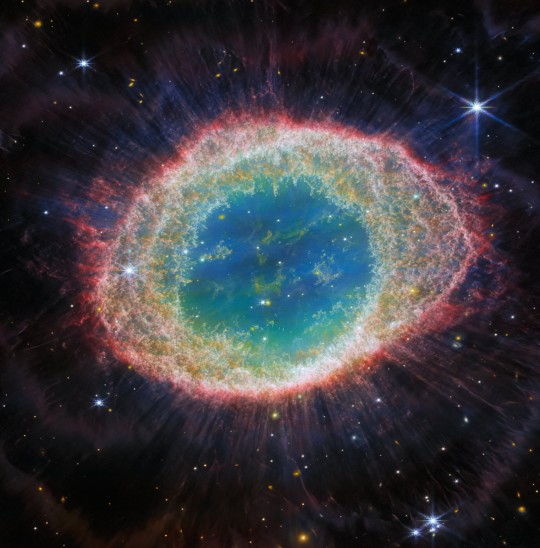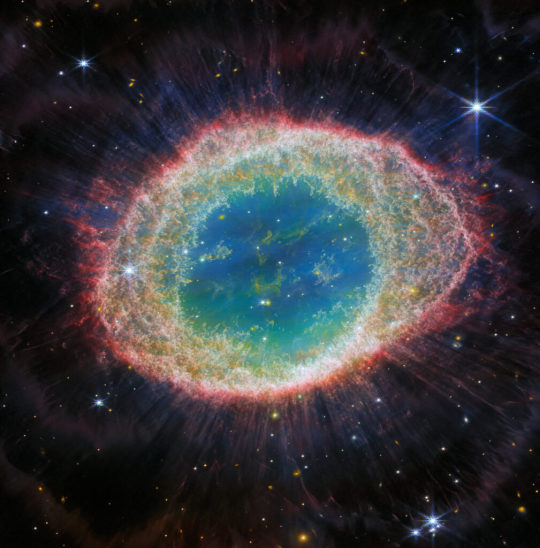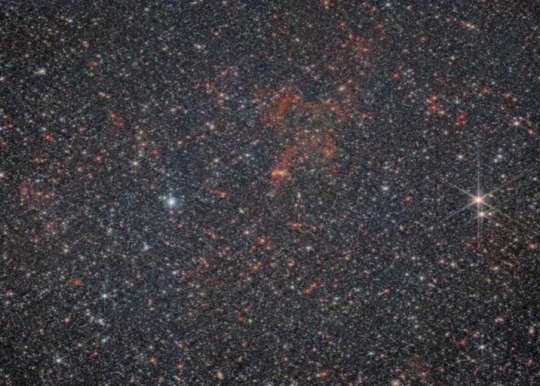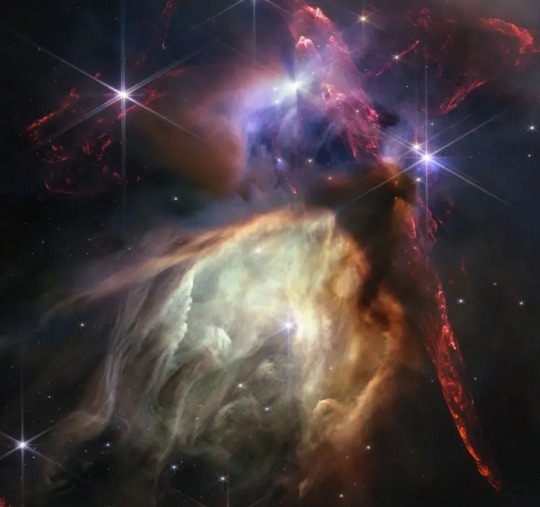#acri-st
Explore tagged Tumblr posts
Text

NASA’s James Webb Telescope Captures the Fiery Remains of a Dying Star in Unprecedented Detail
Images courtesy of ESA/Webb, NASA, CSA, M. Barlow (University College London), N. Cox (ACRI-ST), R. Wesson (Cardiff University)

#nasa#james webb telescope#dying star#european space agency (esa)#m. barlow#university college london#n. cox#acri-st#r. wesson#cardiff university#nature#space#astronomy
54 notes
·
View notes
Text

NASA’s James Webb Space Telescope has observed the well-known Ring Nebula in unprecedented detail. Formed by a star throwing off its outer layers as it runs out of fuel, the Ring Nebula is an archetypal planetary nebula. This new image from Webb’s NIRCam (Near-Infrared Camera) shows intricate details of the filament structure of the inner ring. There are some 20,000 dense globules in the nebula, which are rich in molecular hydrogen. In contrast, the inner region shows very hot gas. The main shell contains a thin ring of enhanced emission from carbon-based molecules known as polycyclic aromatic hydrocarbons (PAHs).
Credit: ESA/Webb, NASA, CSA, M. Barlow (University College London), N. Cox (ACRI-ST), R. Wesson (Cardiff University)
2K notes
·
View notes
Text
The Year’s Most Spectacular Photos from the James Webb Telescope
By Jeffrey Kluger
December 22, 2023

Close to 1,500 light years from Earth lie a pair of baby stellar twins known as Herbig-Haro 46/47 — which are barely a few thousand years old.
A star the size of our sun, by contrast, takes an average of 50 million years to reach even the stellar equivalent of young adulthood It's Herbig-Haro 46/47's extreme youth that gives the formation more of a blob-like appearance than the stellar duo it is.
Young stars are buried in clouds of dust and gas, which they absorb as they grow. Sometimes, however the infant stars ingest too much material too fast.
When that happens, dust and gas erupts from both sides of the formation, giving the young pair their misshapen look.
But if you have patience — 50 million years worth of patience — what is a blob today will be stars tomorrow.
NASA, ESA, CSA. Image Processing: Joseph DePasquale (STScI)

A pair of brilliant stellar nurseries located 1,600 light years from Earth, the Orion Nebula and Trapezium Cluster are home to a relative handful of very young but very bright stars.
Four of the stars are easy to see with a simple, amateur, four-inch telescope.
One of the four — the beast of the young litter — is especially visible, a full 20,000 times brighter than our sun.
Apart from their four main stars, the Orion Nebula and Trapezium cluster contain approximately 700 additional young stars at various stages of gestation.
NASA, ESA, CSA/Science leads and image processing: M. McCaughrean, S. Pearson, CC BY-SA 3.0 IGO

(L): It’s not easy being a Wolf-Rayet star, like this specimen imaged by the Webb telescope at a distance of 15,000 light years.
A rare species of stellar beast — NASA estimates there are only 220 of them in a Milky Way galaxy with at least 100 billion stars — the Wolf-Rayet burns hot and burns fast, with temperatures 20 to 40 times the surface of the sun.
All of that rapidly expended energy causes the star to lose its hydrogen envelope quickly and expose its helium core.
The result: a very early and very violent death.
A star like our sun burns for about 10 billion years. As for a Wolf-Rayet? Just a few hundred thousand before it dissolves into cosmic dust.
NASA, ESA, CSA, STScI, Webb ERO Production Team
(R): If the Wolf-Rayet star dies an ugly and violent death, the celebrated Ring Nebula, photographed by the Webb at a distance of 2,000 light years from Earth, has been expiring beautifully.
The glowing remains of a sun-like star, the nebula was discovered in 1779 by the French astronomer Antoine Darquier de Pellepoix.
As the nebula throws off its outer layers of ionized gas, it reveals its characteristic blue interior, composed of hydrogen and oxygen that have not yet been expelled off by the nebula’s stellar wind.
ESA/Webb, NASA, CSA, M. Barlow (University College London), N. Cox (ACRI-ST), R. Wesson (Cardiff University)

Dwarf galaxy NGC 6822 lives up to to its name — home to just 10 million stars, compared to the minimum of 100 billion in the Milky Way.
But what NGC 6822 lacks in numbers, it makes up in spectacle — which the keen eye of the Webb telescope has revealed.
Discovered in 1884 by American astronomer E.E Barnard, NGC 6822, is now known to have a prodigious dust tail measuring 200 light years across..
What's more, it's home to a dense flock of stars that glow 100,000 times brighter than our sun.
ESA/Webb, NASA & CSA, M. Meixnev

Spiral galaxies are often defined by uneven — and even ragged — arms.
But not galaxy M51, which lies 27 million light years from Earth and is defined by the tautness of its arms and the compactness of its structure.
M51 isn't alone in space. Nearby lies the companion galaxy NGC 5195.
The two galaxies are engaged in something of a gravitational tug of war — one that the NGC 5195 is winning.
NGC's constant gravitational pull is thought to account for both the tightly woven structure of M51's arms and for tidal forces that are thought lead to the creation of new stars in the arms.
ESA/Webb, NASA & CSA, A. Adamo (Stockholm University) and the FEAST JWST team

Just below Orion’s belt lies one of the most celebrated objects in the night sky: the Orion Nebula, a stellar nursery that is home to about 700 young stars.
This Webb image focuses not on the entirety of the nebula but on a structure in the lower left-hand quadrant known as the Orion Bar.
So named because of its diagonal, ridge-like appearance, the bar is shaped by the powerful radiation of the hot, young stars surrounding it.
ESA/Webb, NASA, CSA, M. Zamani (ESA/Webb), and the PDRs4All ERS Team

A baby by stellar standards, the IC 348 Star cluster is just five million years old and located about 1,000 light years from Earth.
Composed of an estimated 700 stars, IC 348 has a structure similar to wispy curtains, created by dust that reflects the light of the stars.
The conspicuous loop in the right hand side of the image is likely created by the gusting of solar winds blowing in the direction that, from Earth, would be west to east.
NASA, ESA, CSA, STScI, Kevin Luhman (PSU), Catarina Alves de Oliveira (ESA)

When it comes to galaxies, there's big and then there's huge and by any measure, Pandora's Cluster — more formally, known as Abell 2744 — qualifies as the latter.
Not just a galaxy, and not even a cluster of galaxies, Abell 2744 is a cluster of four clusters, which long ago collided with one another.
Located 3.5 billion light years from Earth, Pandora's Cluster measures a staggering 350 million years across.
The cluster's massive collective gravity allows astronomers to use it as a gravitational lens, bending and magnifying the light of foreground objects, making them easier to study.
NASA, ESA, CSA, I. Labbe (Swinburne University of Technology) and R. Bezanson (University of Pittsburgh). Image processing: Alyssa Pagan (STScI)

Webb was built principally to look at the oldest and most distant objects in the universe, some of 13.4 billion light years away.
But doesn't prevent the telescope from peering into its own back yard.
This image of Saturn and some of its 146 moons, rivals the images obtained by the Pioneer and Voyager probes.
NASA, ESA, CSA, STScI, Matt Tiscareno (SETI Institute), Matt Hedman (University of Idaho), Maryame El Moutamid (Cornell University), Mark Showalter (SETI Institute), Leigh Fletcher (University of Leicester), Heidi Hammel (AURA). Image processing: J. DePasquale (STScI)

Infant stars are born all over the universe, but the closest stellar birthing suite to Earth is the Rho Ophiuchi cloud complex, located just 460 light years distant.
A turbulent — even violent — place, Rho Ophiuchi is defined by jets of gas roaring from young stars.
Most of the stars in this comparatively modest nursery are more or less the size of the sun.
But one, known as S1, is far bigger — so much so that it is self-immolating, carving a great cavity around itself with its stellar wind, the storm of charged particle's all stars emit, though few with the gale-force power of S1.
NASA, ESA, CSA, STScI, Klaus Pontoppidan (STScI)
#James Webb Telescope#James Webb Space Telescope#telescope#space#stars#galaxies#universe#cosmos#astronomy#space photography#photpgraphy#NASA#galactic clusters#milky way galaxy#Orion’s belt#Orion Nebula#Orion Bar#Pandora's Cluster#Saturn#Rho Ophiuchi cloud complex#Trapezium Cluster#Wolf-Rayet#Ring Nebula#Antoine Darquier de Pellepoix#E.E Barnard#spiral galaxy#nebula
114 notes
·
View notes
Text

The Ring Nebula captured by Webb’s near-infrared camera (NIRCam). ESA/Webb, NASA, CSA, M. Barlow (University College London), N. Cox (ACRI-ST), R. Wesson (Cardiff University)
53 notes
·
View notes
Note
Ranunculus bulbosus, commonly known as bulbous buttercup or St. Anthony's turnip,[1] is a perennial flowering plant in the buttercup family Ranunculaceae. It has bright yellow flowers, and deeply divided, three-lobed long-petioled basal leaves.
The stems are 20–40 cm tall, erect, branching, and slightly hairy, with a swollen corm-like base.[2]: 120 [3] There are alternate and sessile leaves on the stem. The flower forms at the apex of the stems, with 5–7 petals,[3] the sepals strongly reflexed.[2] The flowers are glossy yellow and 1.5–3 cm wide. The plant blooms from April to July.
The native range of Ranunculus bulbosus is Western Europe between about 60°N and the Northern Mediterranean coast. It grows in both the eastern and western parts of North America as an introduced weed.[4] Bulbous buttercup grows in lawns, pastures and fields in general, preferring nutrient-poor, well-drained soils. Although it doesn't generally grow in proper crops or improved grassland, it is often found in hay fields[5] and in coastal grassland.
The bulbous buttercup gets its name from its distinctive perennating organ, a bulb-like swollen underground stem or corm, which is situated just below the soil surface. After the plant dies in heat of summer, the corm survives underground through the winter.[6][7] Although the presence of a corm distinguishes Ranunculus bulbosus from some other species of buttercup such as Ranunculus acris, the species also has distinctive reflexed sepals.
Other names for the bulbous buttercup are "Goldcup" because of the colour and shape of the leaves, and "Frogs-foot" from their form.[8]
This plant, like other buttercups, contains the toxic glycoside ranunculin, which gives it a bitter, acid taste, so cases of poisoning in humans are rare.[9] It is also avoided by livestock when fresh, but when the plant dries the toxin is lost, so hay containing the plant is safe for animal consumption.[3] Pigs are unaffected by the toxin and eat bulbous buttercups avidly, being prepared to travel long distances to find them;[10] hence the folk name of the plant, St Antony's Turnip, after the patron saint of swineherds.

#anon ask#frisk dreemurr#asriel dreemurr#flowey undertale#flowey the flower#flowey#chara dreemurr#ask blog#undertale ask blog#undertale
3 notes
·
View notes
Text

JWST’s mid-infrared view of the Ring Nebula.ESA/WEBB, NASA, CSA, M. BARLOW (UNIVERSITY COLLEGE LONDON), N. COX (ACRI-ST), R. WESSON (CARDIFF UNIVERSITY)
2 notes
·
View notes
Text
James Webb capturó impresionantes imágenes de la nebulosa del Anillo
El Telescopio Espacial James Webb (JWST) de la NASA ha registrado nuevas imágenes impresionantes de la icónica Nebulosa del Anillo, también conocida como Messier 57. Las imágenes, publicadas hoy por un equipo internacional de astrónomos dirigido por el profesor Mike Barlow (UCL, Reino Unido) y el Dr. Nick Cox (ACRI-ST, Francia), con el profesor Albert Zijlstra de la Universidad de Manchester,…

View On WordPress
2 notes
·
View notes
Text
Méduses : vous devriez consulter cette carte avant de partir à la plage
Comment savoir si des méduses sont présentes sur votre plage avant de vous déplacer ? Le laboratoire ACRI-ST, spécialisé dans l'étude de la Terre grâce aux outils satellites, a lancé un
0 notes
Text
Mwapate Capsule Hire Oakleigh
Professional and accredited baby capsule hire, Holiday hire for baby car seats, with safe and trusted Baby seat installation along Bayside Melbourne, south East Suburbs and Select Eastern Suburbs. We are ACRI accredited updated with Kidsafe training. Established in 2012 and trusted by local councils and family day car centres across Melbourne
Website: https://babycarseathire.com
Address: 6 Elizabeth St, Oakleigh East, VIC, 3166
Phone Number: 0479 168 579
Business Hours: Mon - Fri : 09:00 am - 05:00 pm
1 note
·
View note
Text
SPACE: Manchester astronomer captures stunning images of the Ring Nebula [PHOTOS]
NASA’s James Webb Space Telescope (JWST) has recorded breath-taking new images of the iconic Ring Nebula, also known as Messier 57. The images, released today by an international team of astronomers led by Professor Mike Barlow (UCL, UK) and Dr Nick Cox (ACRI-ST, France), with Professor Albert Zijlstra of The University of Manchester, showcase the nebula’s intricate and ethereal beauty in…

View On WordPress
0 notes
Text
Observing phytoplankton via satellite
https://sciencespies.com/nature/observing-phytoplankton-via-satellite/
Observing phytoplankton via satellite
Thanks to a new algorithm, researchers at the AWI can now use satellite data to determine in which parts of the ocean certain types of phytoplankton are dominant. In addition, they can identify toxic algal blooms and assess the effects of global warming on marine plankton, allowing them to draw conclusions regarding water quality and the ramifications for the fishing industry.
The tiny phytoplankton found in the world’s oceans are tremendously productive, and create half the oxygen we need to breathe. Just like land-based plants, they use photosynthesis to produce carbohydrate, which they use as an energy source. They grow, divide and produce enormous quantities of biomass, the basis of all marine life. In addition, they are an essential food source for small crustaceans, fish and mussel larvae, which are themselves staples for larger fish. When phytoplankton are in short supply, it jeopardises the food web for all other marine organisms.
There are various groups of phytoplankton around the globe, and they fulfil different functions in marine ecosystems. Some are favourite food sources; others form specific chemical compounds or serve as nutrient fixers in the water, which can have a major influence on marine flora and fauna. On the other hand, certain groups of phytoplankton can grow to dense masses and produce toxic substances; when there are too many of them in the water, it can be lethal for some marine organisms, especially fish. Marine phytoplankton are also extremely important in their role as a CO2 sink. Accordingly, researchers are keen to learn how the populations of the respective phytoplankton groups are developing around the world.
More than chlorophyll
However, until recently it was virtually impossible to estimate these populations in detail. Granted, researchers have been collecting water samples from on board research vessels for decades, in order to identify and quantify the plankton present. But these are only random samplings. And even satellites, which have been scanning the oceans with their sensors for the past three decades, were an imperfect solution at best: though they could certainly be used to gauge the amount of the plant pigment chlorophyll in the water — as an indicator of how high the general concentration of phytoplankton was — distinguishing between the different types of phytoplankton remained extremely difficult. Moreover, there was no way to use satellite data to predict algal growth in specific regions.
But now an international team led by Hongyan Xi and Astrid Bracher from the Alfred Wegener Institute Helmholtz Centre for Polar and Marine Research (AWI) have for the first time managed to glean far more from satellite data: as they report in the journal Remote Sensing of Environment, working in close cooperation with the French company ACRI-ST and with the support of the European-based satellite data provider Copernicus Marine Environment Monitoring Service, they have developed a new algorithm that can be used to distil the data into key information on five main phytoplankton groups.
Reflectance as a key parameter
Satellite sensors register light at various wavelengths; normally, those wavelengths are used which are capable of picking up the colour of the chlorophyll. But Hongyan Xi and her colleagues have found a way to put this wavelength information to better use. More specifically, this involves analysing an aspect known as reflectance (or coefficient of reflection), which represents the amount of sunlight striking the Earth that is reflected back into space. This reflection is due to numerous optical processes: the light is scattered, bent and altered by water molecules and particles in the ocean and atmosphere alike. “And the plankton, which itself contains certain pigments, has an influence on the reflectance,” Hongyan Xi explains. “The reflectance can differ, depending on which types of plankton and which pigments are dominant in the water.” In fact, each of the five types leaves its own fingerprint on the reflected light — and the new algorithm can recognise them all.
Painstaking comparisons of ship-based and satellite data
This breakthrough was only possible thanks to a tremendous amount of hard work. First the team had to determine which reflectance pattern was characteristic of each plankton type. They then had to compare the satellite readings with plankton samples collected at the same time and place from on board research vessels. Fortunately, the findings of many ship-based expeditions are now available in publicly accessible databases. Thanks to these archives, the experts were able to determine where and when the water samples had been collected, and which species and types of plankton were present. Xi and her colleagues analysed ca. 12,000 of these datasets — and then mapped each and every one to satellite scans taken of the same place at the same time. Doing so allowed them to deduce how the reflectance changed in certain plankton types.
Water quality and toxic algal blooms
Armed with these findings, they were then ready to develop the algorithm. Today, it can be used to determine which types of phytoplankton are dominant in any given marine region worldwide, based on its reflectance information. This is important e.g. to identify toxic “harmful algal blooms” (HABs). The presence of certain types of phytoplankton is also an indicator of water quality; information that is particularly relevant for the fishing industry. According to Hongyan Xi: “In addition, in the future we’ll be able to determine whether or not the distribution of phytoplankton is affected by climate change — an important aspect in terms of predicting the impacts on ecosystems.”
#Nature
2 notes
·
View notes
Text
Sentinel-3 flies tandem
ESA - Sentinel-3 Mission logo. 19 June 2018 The key to monitoring Earth’s changing environment and to guaranteeing a consistent stream of satellite data to improve our daily lives is to take the same measurements over the course of decades. But how do you know that measurements from successive satellites, even though identical in build, are like for like? The answer, for the Copernicus Sentinel-3 mission, is to engage in some nifty orbital flying.
Tandem in images
Sentinel-3 is a two-satellite mission to supply the coverage and data delivery needed for Europe’s Copernicus environmental monitoring programme. Launched in 2016, Sentinel-3A has been measuring our oceans, land, ice and atmosphere to monitor and understand large-scale global dynamics and to provide critical information for marine operations, and more. Its twin, Sentinel-3B, was launched in April 2018 and is having its instruments calibrated and being commissioned for service. Once Sentinel-3B is operational, the two satellites will orbit Earth 140° apart.
Sentinel-3 spacecraft
Now, however, the satellites have been positioned much closer together, flying a mere 30 seconds apart. Travelling at 7.4 km per second, the separation equates to a distance of 223 km. The reason for this is to see how their instruments compare. Even though the two Sentinel-3 satellites are identical, each carrying a radar altimeter, a radiometer and an imaging spectrometer, there’s a chance that their instruments could behave slightly differently. It is important that any differences are carefully accounted for otherwise the information they deliver could be misinterpreted as changes happening on Earth’s surface. Given the satellites’ current brief separation, their measurements should be virtually the same.
Sentinel-3 going tandem
This tandem phase is also important for the future Sentinel-3 satellites. ESA’s ocean scientist, Craig Donlon, explains, “Our Sentinel-3 ocean climate record will eventually be derived from four satellites because we will be launching two further Sentinel-3s in the future. “We need to understand the small differences between each successive satellite instrument as these influence our ability to determine accurate climate trends. “The four-month Sentinel-3 tandem phase is a fantastic opportunity to do this and will provide results so that climate scientists can use all Sentinel-3 data with confidence.” ESA’s Sentinel-3 project manager, Bruno Berruti, said, “Following liftoff and the usual checks, the operations team has been expertly flying Sentinel-3B so that it gradually flies closer to Sentinel-3A.
Sentinel-3 comparison
“We recently reached the magic separation of 30 seconds and I am happy to say that we are now officially in the tandem phase. “This will last around four months, after which the two satellites will be gently moved apart until they reach their operational separation of 140°. This is different to the other Sentinel missions, but for our mission it is better to measure ocean features such as eddies as accurately as possible.” ESA’s Sentinel-3 mission manager, Susanne Mecklenburg, added, “So far, we are really happy with the results of the tandem phase. Measurements from the satellites’ instrument packages seem to be very much aligned, but we will be analysing the results very carefully over the next months to make sure we account for any minor differences.” Related links: Sentinel-3: http://www.esa.int/Our_Activities/Observing_the_Earth/Copernicus/Sentinel-3 Sentinel data access: https://scihub.copernicus.eu/ Images, Text, Credits: ESA/contains modified Copernicus Sentinel data (2018), processed by ESA/S3MPC/ACRI-ST/ESA, CC BY-SA 3.0 IGO. Best regards, Orbiter.ch Full article
19 notes
·
View notes
Text
Acco, Ptolemais, Acre Also known as Tel 'Akko/Acco, Tel/Tell el-Fukhkhar, Tell el-Fukhar, Acca, Accho, Acon, Acre, Acri, Ake, 'Akka, Akko, Antiochenes, Antiochia Ptolemais, Ptolemais Antiochenes, Ocina, St. Jean d'Acre
Acco, Ptolemais, Acre Also known as Tel ‘Akko/Acco, Tel/Tell el-Fukhkhar, Tell el-Fukhar, Acca, Accho, Acon, Acre, Acri, Ake, ‘Akka, Akko, Antiochenes, Antiochia Ptolemais, Ptolemais Antiochenes, Ocina, St. Jean d’Acre
Port City of Acco Acco is only referenced once in the Bible by this name. In Judges 1:31, it is referred to as one of the places the Israelites failed to hold. In the New Testament, Acco was known as Ptolemais and was one of the stops on Paul’s final return to Jerusalem (Acts 21:7). Ptolemais was situated on the main sea and land route in ancient times. It served as the main port of the region…

View On WordPress
0 notes
Photo
Rona ( gaelico scozzese : Rònaigh ) è un'isola scozzese remota e disabitata nel Nord Atlantico.
Rona viene spesso chiamata Rona settentrionale per distinguerla da Rona meridionale (un'altra piccola isola, nelle Ebridi Interne ).
Ha una superficie di 109 ettari (270 acri) e un'altitudine massima di 108 metri (354 piedi). [È compreso nella contea di Ross-shire ( Ross e Cromarty ).
L'isola si trova a 71 chilometri (44 miglia) a nord-ovest di Cape Wrath , la stessa distanza a nord-nord-est del Butt of Lewis e 18 km (11 miglia) a est di Sula Sgeir . Più isolata di St Kilda , è l'isola più remota delle isole britanniche ad essere stata abitata a lungo termine.
È anche il vicino più vicino alle Isole Faroe.
A causa della posizione remota dell'isola e della piccola area, è omessa da molte mappe del Regno Unito.

Welcoming by Rona’s whereabouts on Flickr.
323 notes
·
View notes

